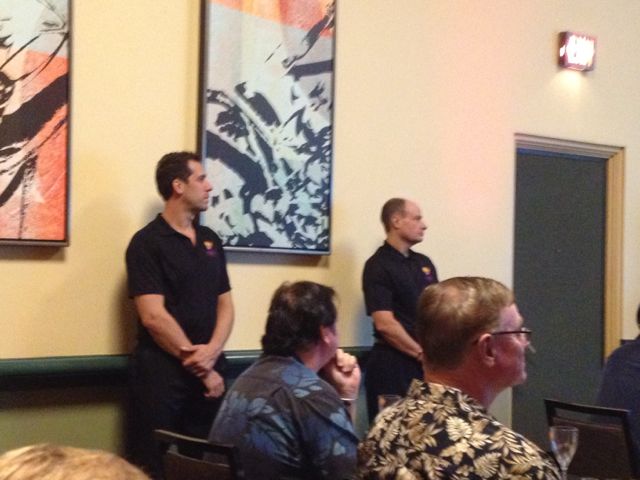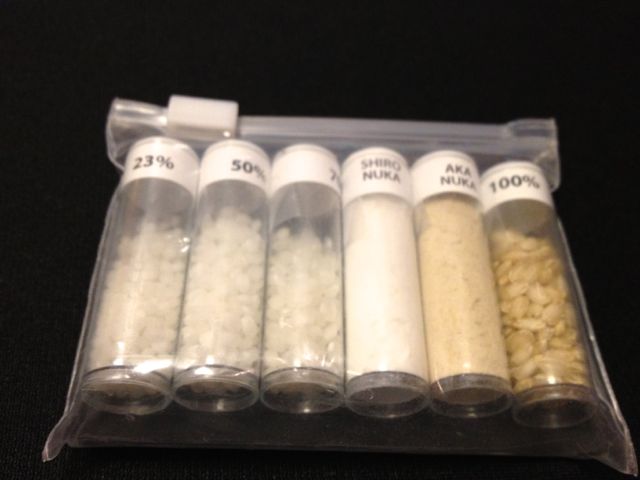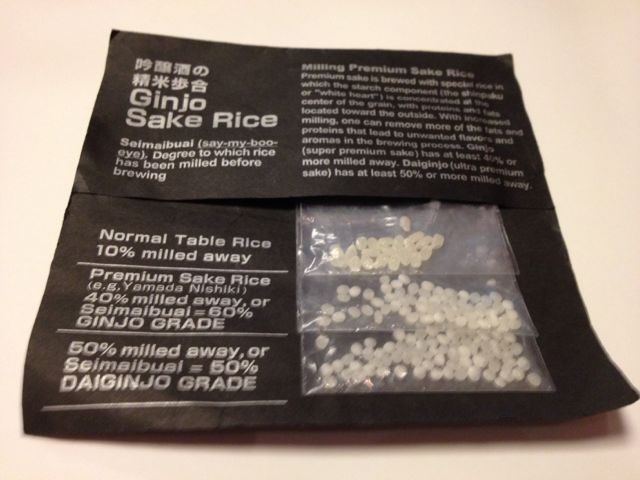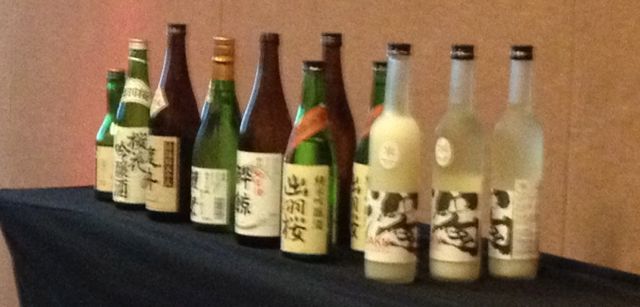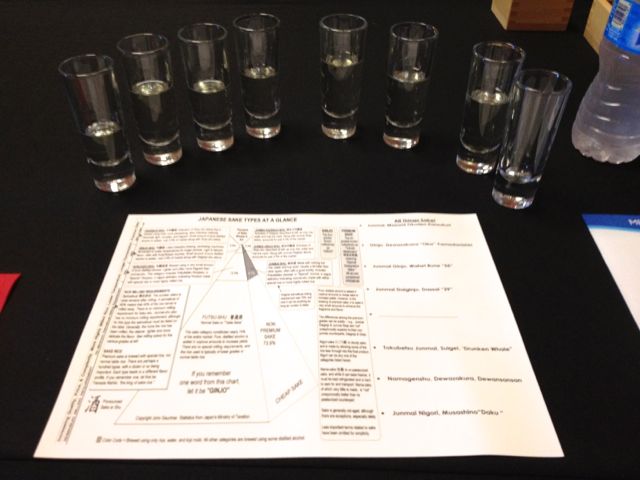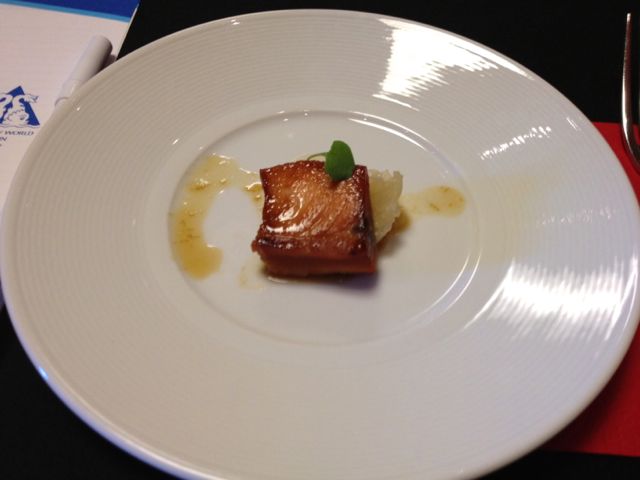We’re back again! This is the third year for Chad’s Sake Class at the Swan and Dolphin Food and Wine Classic and this year nora again attended both evenings (on Friday night she and nick attended and on Saturday night, nora sat with three of our guests for the Classic while nick and Calvin went to the Beer, Please seminar). Since this is three years in a row and since we’ve covered sake in a lot of detail in the past (Food & Wine Classic 2010, Food & Wine Classic 2011, Food & Sake Pairing 2010, and Food & Sake Pairing 2011), there may be less background detail than in the past — if you want more information or need a refresher course on sake, please check these out.
On Friday night, Chad, Aaron, and Joe were there to help everyone along while exploring “All Things Sake!” (14 of 20 seats filled) – On Saturday night, Chad and Joe were our instructors or sake guides (10 of 20 seats filled).
Chad came to the Swan and Dolphin in 2010 to become the manager at Kimonos (the sushi bar in the Swan hotel), at that point, all he knew about sake was what most people know… sake is the hot drink at sushi bars and you can make sake-beer bombs. His new boss told him that he was going to teach a sake seminar in October during this new event, the Swan and Dolphin Food & Wine Classic – so Chad went and got all the books he could find written in English about sake and started studying. After he taught the seminar in 2010, he went to Portland (John Gauntner, sake-world.com) and became a sake specialist.
Sake is very interesting, it doesn’t fit into any of the regular alcoholic drink categories: beer, wine, or spirit. But it is closer to a beer than anything else. The historical fable is that some japanese, a very long time ago, like to just crunch on plain rice, they’d spit it into a bucket when they got tired of it, after a while it would ferment & that’s the roots of sake (yuck!). Chad made the comment that he couldn’t really figure out what desperation would make you want to drink something like that in the first place – who was the guy who said “oh, let’s taste that and see what it’s like!” nora says that guy was probably related to the first guy who ate raw oysters…
Sake is brewed from rice. The process seems pretty simple to us by now: Mill rice. Steam rice. Sprinkle about 10% of rice with koji mold (inoculate it), mix it up. Add back to other rice, add water. Koji turns rice starch into sugar. Add yeast, yeast turns sugar into alcohol. Sake! A sake brewer is a “toji”, the sake brewery is the “kura”, and the word “sake” refers to any alcohol in Japan, they call it “o-sake” (and a bunch of other names too!).
Wine has about 200 flavor components while Sake has about 400 flavor components (Oh wow!) – this makes sake good for cooking, Chad recommended making “sake in a soup can chicken” instead of “beer can chicken”, he said it makes a great risotto, and he even said he’d heard of someone making a really delicious fruitcake with hisui (red sake) <wink wink>. Oh yes, he also shared a recipe for a Sake Martini which is very popular at Kimonos (1.5 oz vodka, muddle a cucumber in it, add 1.5 oz sake and a little bit of simple syrup, shake with ice, strain).
The “good stuff” that we enjoy today has been around for about 60 to 70 years. Futsu-shu, the hot sake nearly everyone is familiar with, is a product of WWII and is really a sake flavored alcohol. There were shortages of rice, so the “sake flavored” beverage came into being; it’s usually drunk warm for a couple of reasons: (1) warming it up hides some of its harshness and (2) the Japanese believe that it’s good for your body to drink warm things…
More cultural things about sake:
- Most of the o-sake produced in Japan, stays in Japan
- You don’t pour sake for yourself, a friend or colleague pours it for you as a sign of respect, and if someone pours sake for you, you should drink it as a return of respect
- Sake is very much a part of the culture and religiosity of Japan – Joe has fond memories of getting a chilled sake after entering some parks in Japan and simply strolling along sipping his sake, unlike in the US where there would be a bit of a stigma about drinking in public during the day, in Japan you can have your o-sake and enjoy it just about anywhere
- When you drink sake, you want “a little buzz” kinda like your feet are barely touching the ground (not like the ground is rushing up to meet your face!)
We’ve talked a lot in previous posts about how the rice is milled and how the quality of a sake is somewhat dependent on how much the grains are milled… NEW FACT: The percent milling is determined by the weight loss during the process, not by actually measuring grains of rice to see how much smaller they are. The more the rice grains are milled, the more congeners are removed and thus the less “contaminated” (i.e. hangover producing) that 0-sake will be.
And lastly, Chad talked about “soju” with is another alcohol made with rice or other starches, it’s not really o-sake and it has half the calories of vodka.
On to the tastings!
First – Junmai, Masumi Okuden Kansukuri
- nora’s notes: a little fruity, nose = a little alcohol, slightly fruity, taste = cherry blossoms, follow-on taste = light, not heavily alcoholic, 2/4 on nora’s favorite scale
- nick’s notes: sweet fruit smell, some alcohol on the tongue but no flavors are particularly pronounced, doesn’t taste really “clean”
Second – Ginjo, Dewazakurra “Oka” Yamadanishki
- “yamadanishki” is the kind of rice, it’s the cadillac of rice; hard to grow and hard to mill without fracturing the rice grains
- it’s peach, floral and sweeter than the first o-sake; the brewer chose to add just a little grain alcohol to bring out the aromas and flavors (note: alcohol is added to “ginjo” as an enhancement of flavors and aromas, the amounts are too small for the alcohol to actually boost the alcohol content)
- nora’s notes: nose = cantaloup, banana, a tiny floral scent; taste = richer, a little heavier, 2/4 on nora’s favorite scale
- nick’s notes: “Oka” means cherry bouquet; less nose, maybe slightly ripe (not green) banana; no pronounced flavor, do think some hint of more alcohol on the tongue; not impressively memorable
Third – Junmai Ginjo, Watari Bune “55”
- the “55” refers to 55% milled
- Joe suggested that this will pair well with the daikon on our tasting dish
- Chad likened this to a “chardonnay” – big buttery full flavors
- nora’s notes: nose = not as floral as #2; taste = a bit nutty, maybe a little buttery, 3/4 on nora’s favorite scale
- nick’s notes: one of Chad’s favorites for the tastings we’re doing tonight; more banana nut and it seems “smoother” smelling; mouth seems drier than the first two o-sakes; it doesn’t taste like it smells; it’s okay, but I think I like more flavorful sakes… WOW – much better after a bit of salmon!
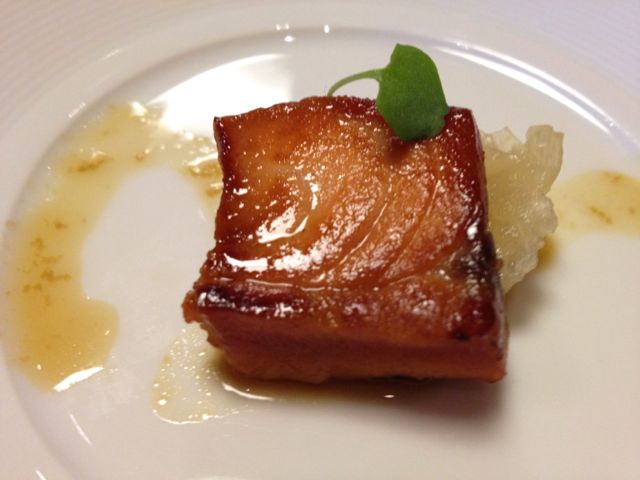
the salmon was about the size of a postage stamp… bring back the shrimp and pineapple in coconut sauce
Fourth Sake – Junmai Daiginjo, Dassai “39”
- the “39” again refers to the level of milling of the rice grains
- nora’s notes: Friday nose = light fruitiness, a little floral & Saturday nose = fruity, cantaloup, pineapple; Friday taste = a little richer & Saturday taste = buttery with the salmon; 1/4 on Friday night and 4/4 on Saturday night — the difference? the temperature, Friday it was at room temperature and Saturday it was slightly chilled
- nick’s notes: sweeter nose/richer, just has something more, very light flavor compared to the smell; I think that the Junmai Ginjo tastes better with the salmon than this one does
Fifth Sake – was a surprise, Chad didn’t tell us what it was until after the tasting and discussion – Junmai Daiginjo, Dassai “50”
- Chad said this was a little lighter than number 4
- nora’s notes: Friday nose = a little anise & Saturday nose = fuller, richer, spicier than number 4; Friday taste = creamy, a little later the creamy aspect is still dominant & Saturday taste = spicier and much fuller; 4/4 on Friday night and 3/4 on Saturday night — difference? again it was the temperature, on Friday this one was more chilled
- nick’s notes: smells spicier than #4, sweeter and drier, also better with the salmon than #4
Sixth Sake – Tokubetsu Junmai, Suigei, “Drunken Whale”
- “tokubetsu” means that the brewer felt passionately that this was his best work
- named after a japanese samurai that drank like a whale
- Chad says, “best at room temperature, rich like a Cabernet”
- nora’s notes: nose = a little melon, some nuttiness, some creaminess; taste = rich, quick evaporation in the mouth; I like it; later taste… seems more bitter (like a bitter lager or ale); 1/4 on nora’s favorite scale
- nick’s notes: very full rich smell; slightly dry, very short flavor – hard to sense flavor; doesn’t pair well with the salmon
Seventh Sake – Namagenshu, Dewazakura, Dewansansan
- “nama” means naked, unpasturized
- “genshu” means no added water (final alcohol content is not adjusted using water)
- this type of sake is representative of an emerging market
- Chad says it should be a little sharp, a little gamey
- nora’s notes: nose = a little more strength; taste = I like, a little cherry, a little kick; second taste = definitely gamey; 1.5/4 on nora’s favorite scale
- nick’s notes: something sweet on nose but I can’t identify what it is; smooth mouth but sharp at edges of tongue; good with salmon but probably not the best of what we’ve tried
Eight Sake – Junmai Nigori, Mushashino “Daku”
- nigori is unfiltered sake
- Chad says he gets lychee and coconut aromas and tastes
- nora’s notes: nose = banana ice cream; can see the sediment; taste = sweet and creamy; this could be very sneaky; second taste = even creamier; 4/4 on nora’s favorite scale
- nick’s notes: hints of coconut and riper banana; sweeter but not too much; slightly dry at edges of tongue; would not drink alone but maybe in a better pairing?
- nick sipped all 8 one after another; pulled #2, #5, and #7 toward him as best to his taste without food; probably #2 and #7 taste best by themselves; looking at tasting notes, surprised that I like #2; decided that #7 is favorite (that’s the namagenshu)
- nora also sipped all 8 one after another to try and rank the whole selection; #4 is sweeter and more floral than #5 which is spicier and creamier; liked #5 and #8 best on Friday night and liked #4 and #8 best on Saturday night

